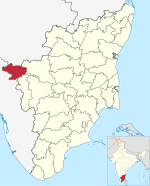Pandalur taluk
Pandalur taluk | |
|---|---|
Taluk | |
Gudalur |
Pandalur taluk is a
History
The Gudalur and Pandalur taluks of Nilgiris district one time together constituted the Southeast
Pre-history
Historians believe that the human settlements existed in these parts for at least ten centuries
Ezhimala kingdom
In the earliest part of the recorded history of Gudalur region, Wayanad District, Kasaragod-Kannur-Wayanad-Kozhikode Districts in the northern part of present-day Kerala were ruled by the Nannans (
Kolathunadu
The Mooshaka Kings were considered descendants of Nannan. By the 14th century,
Kingdom of Kottayam
The
Carnatic invasions into Wayanad and Gudalur
In 930 CE, emperor Erayappa of
Mysore Sultans
When
Colonial era
- Munnanad
- Nambalakode
- Cherankode[12]
During the mid-19th century, English companies began mining for gold in the area, mostly in Devala and Pandalur. A London-based mining company created a township in Pandalur that began with a church, post office, shops, and a race course. After the gold boom, the mining business gradually fell into decline because the percentage of gold ore was below the average. Even so, mining was continued until the beginning of the 20th century.
Once the British companies had determined that gold mining would not succeed in this area, thus changing to agricultural industries and created
Kunjalikutty Haji of Pandalur was one of the leading manpower suppliers for British estates.

He brought a large number of people from
Most of the land in this area was the property of the princely states of Nilambur, Kovilagam, and Mysoor Maharaj. The Nelliyalam Rani administered the region for Mysoor Maharaj and enjoyed the highest rank in society. The remains of the Nelliayalam Ranis fort can still be viewed in the Nelliayalam village.
Pandalur was believed to be a sacred place for the aboriginal communities such as the Paniyas, Kurumbas, and Kattu Nayakkans. It was then dominated by the Gowdar community. In Ponnani, near the village of Nelliyalkam, there is a century-old temple (Sree Maha Vishnu Temple) constructed in the unique Kerala temple architecture. The migration of Malabar people had a major impact on the area, including the social, cultural, economic, and environmental systems.
Demographics
According to the 2011 census, the taluk of Pandalur had a population of 125,877 with 61,538 males and 64,339 females. There were 1046 women for every 1000 men. The taluk had a literacy rate of 78.89. Child population in the age group below 6 was 6,123 Males and 5,996 females.[13]
Religions
According to 2011 census report, Pandalur taluk had 71.37% Hindus, 17.83% Muslims, 10.61% Christians and others.
Languages
References
- ^ a b c d e M. Vijayanunni (1983). 1981 Census Handbook- Wayanad District (Part-A&B) (PDF). Directorate of Census Operations, Kerala.
- ^ "Wayanad - A secton of Western Ghats". Anand Bharat. 27 November 2017. Retrieved 7 January 2020.
- ^ Census of India, 2001: Wayanad. Controller of Publications. 2004. p. 4.
- ^ Census of India, 1991: pt. 2A. General population tables. Controller of Publications. 1995. p. 13.
- ^ District Census Handbook, Kasaragod (2011) (PDF). Thiruvananthapuram: Directorate of Census Operation, Kerala. p. 9.
- ISBN 9788120604476.
- ^ The Hindu staff reporter (21 November 2011). "Neeleswaram fete to showcase its heritage". The Hindu. Retrieved 24 November 2016.
- ^ Government of India (2014–15). District Census Handbook – Wayanad (Part-B) 2011 (PDF). Directorate of Census Operations, Kerala.
- ^ Moraes, George M (1931). The Kadamba Kula: A History of Ancient and Medieval Karnataka. Bombay: B X Furtado And Sons. pp. 83–84. Retrieved 31 August 2021.
- ^ Madrass District Gazetteeers, The Nilgiris. By W. Francic. Madras 1908 Pages 90-104
- ^ Report of the Administration of Mysore 1863-64. British Parliament Library
- ^ a b Logan, William (1887). Malabar Manual (Volume-2). Madras: PRINTED BY R. HILL, AT THE GOVERNMENT PRESS.
- ^ "Provisional Population Totals - Tamil Nadu-Census 2011" (PDF). Census Tamil Nadu. Archived from the original (PDF) on 17 June 2013. Retrieved 4 July 2013.
- ^ "Census of India - Language". censusindia.gov.in. Retrieved 17 April 2020.

